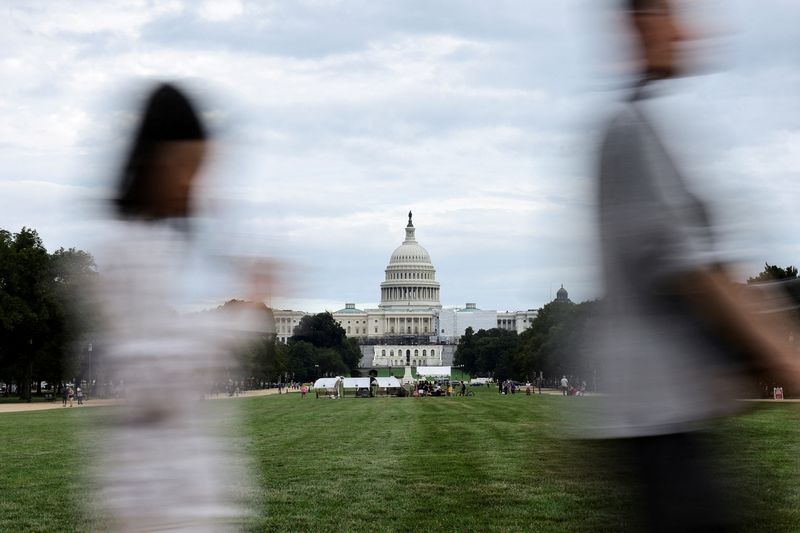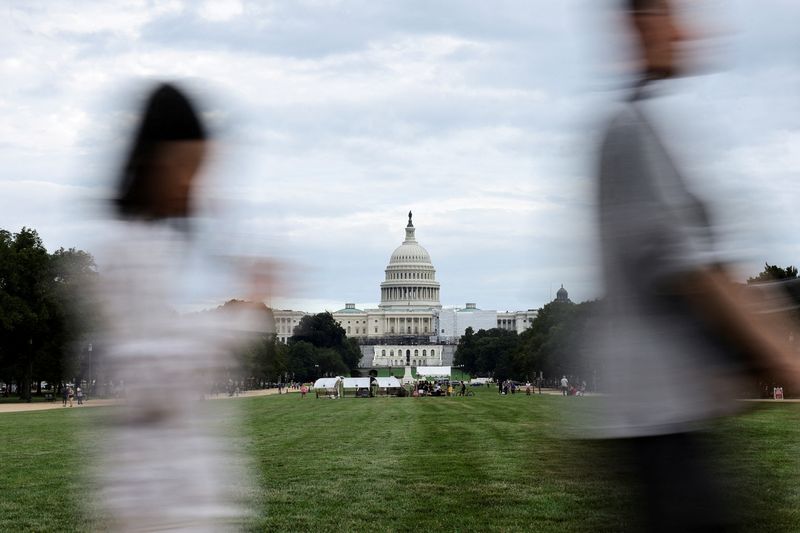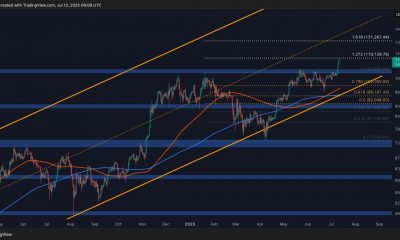Economy
Full US government shutdown likely, could impact Fed -PIMCO


© Reuters. FILE PHOTO: People walk at the National Mall in front of the Capitol in Washington, U.S. August 29, 2023. REUTERS/Kevin Wurm/File Photo
By David Randall and Dhara Ranasinghe
NEW YORK (Reuters) – A full, lengthy shutdown of the U.S. government is “likely” at the end of the month and could leave the Federal Reserve reluctant to raise interest rates in November, analysts at bond giant PIMCO said in a note on Tuesday.
“If the government shuts down, there may not be a catalyst for it to reopen given the complicated internal dynamics of House Republicans,” said Libby Cantrill, head of public policy at PIMCO, which oversees $1.79 trillion in assets.
Current funding for most U.S. government programs except for the military and Social Security payments expires on Sept. 30. If lawmakers are unable to pass a new budget by then, large swaths of government functions would shut down, an event strategists at Goldman Sachs estimate would reduce U.S. economic growth by 0.2% for each week it lasted.
A government shutdown is not seen as toxic a threat to the economy as a default on its debt, which Congress avoided by raising the debt ceiling earlier this year.
The government would continue to make payments on Treasury bonds and other forms of debt during a shutdown.
U.S. House of Representatives Speaker Kevin McCarthy told reporters on Monday he would bring two spending bills to the House floor for consideration this week, including a short-term stopgap measure, to see if they can pass.
Congress is unlikely to pass spending bills quickly due to a renewed focus on deficits among Republicans and some moderate Democrats after the large fiscal stimulus programs that supported the economy during the COVID-19 pandemic, Cantrill said in a panel last week.
“There’s now really a focus on austerity,” she said.
A government shutdown would prevent the collection and release of key market data including gross domestic product, unemployment figures and inflation data, clouding the ability of central bankers to gauge the strength of the economy, Cantrill said.
“The Fed – who has emphasized how data-dependent it currently is – would be flying blind” into the central bank’s policy meeting in November, she said.
At the same time, a shutdown would coincide with the resumption of student loan payments, rising gasoline prices and an auto worker strike, potentially increasing the economic impact of furloughing nonessential government employees, Cantrill said.
The impact of past shutdowns on U.S. stocks has been slight. The has fallen by an average of 0.4% in the week before a shutdown, and gained a total of 0.1% over the length of all shutdowns since 1976, according to CFRA Research data.
Economists at Capital Economists, meanwhile, said in a note on Monday that the risk of a shutdown is rising but said they expect a quick resolution.
Economy
Russian central bank says it needs months to make sure CPI falling before rate cuts -RBC


© Reuters. Russian Central Bank Governor Elvira Nabiullina attends a news conference in Moscow, Russia June 14, 2019. REUTERS/Shamil Zhumatov/File Photo
MOSCOW (Reuters) – Russia’s central bank will need two to three months to make sure that inflation is steadily declining before taking any decision on interest rate cuts, the bank’s governor Elvira Nabiullina told RBC media on Sunday.
The central bank raised its key interest rate by 100 basis points to 16% earlier in December, hiking for the fifth consecutive meeting in response to stubborn inflation, and suggested that its tightening cycle was nearly over.
Nabiullina said it was not yet clear when exactly the regulator would start cutting rates, however.
“We really need to make sure that inflation is steadily decreasing, that these are not one-off factors that can affect the rate of price growth in a particular month,” she said.
Nabiullina said the bank was taking into account a wide range of indicators but primarily those that “characterize the stability of inflation”.
“This will take two or three months or more – it depends on how much the wide range of indicators that characterize sustainable inflation declines,” she said.
The bank will next convene to set its benchmark rate on Feb. 16.
The governor also said the bank should have started monetary policy tightening earlier than in July, when it embarked on the rate-hiking cycle.
Economy
China identifies second set of projects in $140 billion spending plan


© Reuters. FILE PHOTO: Workers walk past an under-construction area with completed office towers in the background, in Shenzhen’s Qianhai new district, Guangdong province, China August 25, 2023. REUTERS/David Kirton/File Photo
SHANGHAI (Reuters) – China’s top planning body said on Saturday it had identified a second batch of public investment projects, including flood control and disaster relief programmes, under a bond issuance and investment plan announced in October to boost the economy.
With the latest tranche, China has now earmarked more than 800 billion yuan of its 1 trillion yuan ($140 billion) in additional government bond issuance in the fourth quarter, as it focuses on fiscal steps to shore up the flagging economy.
The National Development and Reform Commission (NDRC) said in a statement on Saturday it had identified 9,600 projects with planned investment of more than 560 billion yuan.
China’s economy, the world’s second largest, is struggling to regain its footing post-COVID-19 as policymakers grapple with tepid consumer demand, weak exports, falling foreign investment and a deepening real estate crisis.
The 1 trillion yuan in additional bond issuance will widen China’s 2023 budget deficit ratio to around 3.8 percent from 3 percent, the state-run Xinhua news agency has said.
“Construction of the projects will improve China’s flood control system, emergency response mechanism and disaster relief capabilities, and better protect people’s lives and property, so it is very significant,” the NDRC said.
The agency said it will coordinate with other government bodies to make sure that funds are allocated speedily for investment and that high standards of quality are maintained in project construction.
($1 = 7.1315 renminbi)
Economy
Russian central bank says it needs months to make sure CPI falling before rate cuts -RBC


© Reuters. Russian Central Bank Governor Elvira Nabiullina attends a news conference in Moscow, Russia June 14, 2019. REUTERS/Shamil Zhumatov/File Photo
MOSCOW (Reuters) – Russia’s central bank will need two to three months to make sure that inflation is steadily declining before taking any decision on interest rate cuts, the bank’s governor Elvira Nabiullina told RBC media on Sunday.
The central bank raised its key interest rate by 100 basis points to 16% earlier in December, hiking for the fifth consecutive meeting in response to stubborn inflation, and suggested that its tightening cycle was nearly over.
Nabiullina said it was not yet clear when exactly the regulator would start cutting rates, however.
“We really need to make sure that inflation is steadily decreasing, that these are not one-off factors that can affect the rate of price growth in a particular month,” she said.
Nabiullina said the bank was taking into account a wide range of indicators but primarily those that “characterize the stability of inflation”.
“This will take two or three months or more – it depends on how much the wide range of indicators that characterize sustainable inflation declines,” she said.
The bank will next convene to set its benchmark rate on Feb. 16.
The governor also said the bank should have started monetary policy tightening earlier than in July, when it embarked on the rate-hiking cycle.

 Forex3 years ago
Forex3 years agoForex Today: the dollar is gaining strength amid gloomy sentiment at the start of the Fed’s week

 Forex3 years ago
Forex3 years agoUnbiased review of Pocket Option broker

 Forex3 years ago
Forex3 years agoDollar to pound sterling exchange rate today: Pound plummeted to its lowest since 1985

 Forex3 years ago
Forex3 years agoHow is the Australian dollar doing today?

 Cryptocurrency3 years ago
Cryptocurrency3 years agoWhat happened in the crypto market – current events today

 World3 years ago
World3 years agoWhy are modern video games an art form?

 Commodities3 years ago
Commodities3 years agoCopper continues to fall in price on expectations of lower demand in China

 Economy3 years ago
Economy3 years agoCrude oil tankers double in price due to EU anti-Russian sanctions



























